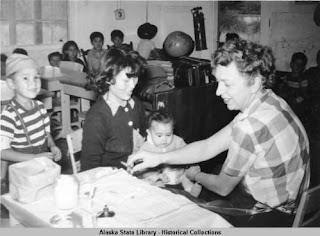Life during the coronavirus pandemic has inspired us to look back at how Alaskans handled outbreaks in the past through our collections.
1918 Influenza
 |
| This gossip column from the Alaska Daily Empire, November 16, 1918, proves that social distancing has been around for more than a hundred years. |
The 1918 influenza epidemic has numerous parallels to today's coronavirus situation. Movement was restricted, quarantines imposed, and communities converted spaces into field hospitals and recovery wards. Helen Wilson, a teacher in Skagway, volunteered to cook and keep house at the White Pass Rooming House, which became an overflow area for flu patients. You can read her letter to her mother about bringing the cooked chicken she'd planned for a dinner to the Rooming House in a taxi with her oil stove strapped to the running board on
Alaska's Digital Archives. Last week, Twitter user @alaskarobotics posted
a round-up of flu-related (and some just humorous) snippets from Alaska newspapers that he found on
Chronicling America.
1925 Diphtheria
 |
| Gunnar Kasson and Balto in their race to Nome. Alaska State Library Portrait File, ASL-Kasson-Gunnar. |
Alaska's most famous epidemic may be the one that spurred the great serum run in 1925. Diphtheria broke out in Nome and the only option for transporting the antitoxin from Nenana was by dog sled. Mushers and their dogs, like Leonhard Seppala with Togo and Gunnar Kasson with Balto, braved gale force winds, -85 degree temperatures, and whiteout conditions to make the 674-mile delivery in 127.5 hours and become nationwide heroes. You can follow the mushers' progress through
telegrams posted to Governor Scott C. Bone, from the governor's correspondence files
digitized by the Alaska State Archives.
1940s-1950s Tuberculosis
 |
| An "itinerant" nurse with the Territorial Department of Health sees a young patient in Tanacross. Alaska State Library Historical Collections, ASL-P143-1018. |
After World War II, tuberculosis was a major health crisis in Alaska. The Territorial Department of Health deployed mobile clinics, including a decommissioned military ship, two barges, two railway cars, and a truck, to rural communities to provide basic health care and training. Tuberculosis still took a heavy toll on Alaskans, and in 1946, a 150-bed tuberculosis sanitorium opened in Seward. Patients there published a
newspaper called San Chat with patient spotlights, updates from former staff, and drawings, poems, and stories by residents.
Then, as now, Alaskans got through bad times by lending a helping hand, demonstrating their courage and perseverance, and using their resourcefulness and creativity to lift each other up.
More links:




